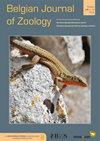Skeletal deformities in gilthead seabream (Sparus aurata): exploring the association between mechanical loading and opercular deformation
IF 1.1
4区 生物学
Q2 ZOOLOGY
引用次数: 1
Abstract
Fish aquaculture is frequently confronted with skeletal abnormalities. In gilthead seabream (Sparus aurata (Linnaeus, 1758)), opercular deformities are one of the most common types of deformities. Many studies point at potential causal factors, mainly genetic or nutritional. However, no clear consensus has surfaced yet, and other factors known to affect bone formation remain unexplored, including mechanical stressors by external forces or muscle contraction. In this study, we investigated whether an altered mechanical use of the gill cover could be associated with opercular deformities, by inducing a change in the respiratory rate and thus gill ventilation. Juvenile seabreams were reared under 80, 100 or 200% dissolved oxygen (DO) to trigger altered respiration behaviour, and the effect on body and opercular shape was analysed. The main hypothesis was that hypoxic conditions would increase opercular ventilation, which would result in a higher prevalence of opercular deformities. The results show that the hypoxic condition (80% DO) did not trigger a significantly higher prevalence of opercular deformations, though the opposite is true for the hyperoxic condition (200% DO). No effect of oxygen treatment was observed on overall body shape, though deformed opercles showed a pronounced, but non-significant difference in shape across treatments. Morphometric results and µCT scans reveal that deformations mainly occur in the dorsocaudal region of the opercular bone. Although no causal link could be demonstrated, we discuss how these results can indirectly suggest that an altered mechanical loading on the operculum could explain its deformation.金头海鲷(Sparus aurata)的骨骼畸形:探索机械载荷与眼周变形之间的关系
鱼类养殖经常面临骨骼异常的问题。在金头鲷(Sparus aurata(Linnaeus,1758))中,顶盖畸形是最常见的畸形类型之一。许多研究指出了潜在的因果因素,主要是遗传或营养因素。然而,目前还没有明确的共识浮出水面,其他已知影响骨形成的因素仍有待探索,包括外力或肌肉收缩引起的机械应激。在这项研究中,我们通过诱导呼吸频率和鳃通气的变化,研究了鳃盖机械使用的改变是否与盖畸形有关。幼鱼在80%、100%或200%的溶解氧(DO)下饲养,以触发呼吸行为的改变,并分析其对身体和操纵管形状的影响。主要假设是缺氧条件会增加房盖通气,从而导致房盖畸形的发生率更高。结果表明,低氧条件(80%DO)不会引发明显更高的操纵管变形发生率,尽管高氧条件(200%DO)的情况正好相反。氧气处理对整体体型没有影响,尽管变形的操纵子在不同处理中表现出明显但不显著的形状差异。形态测量结果和µCT扫描显示,变形主要发生在盖骨的背侧区域。尽管没有因果关系可以证明,但我们讨论了这些结果如何间接地表明,盖上机械负荷的改变可以解释其变形。
本文章由计算机程序翻译,如有差异,请以英文原文为准。
求助全文
约1分钟内获得全文
求助全文
来源期刊

Belgian Journal of Zoology
生物-动物学
CiteScore
1.90
自引率
0.00%
发文量
10
审稿时长
>12 weeks
期刊介绍:
The Belgian Journal of Zoology is an open access journal publishing high-quality research papers in English that are original, of broad interest and hypothesis-driven. Manuscripts on all aspects of zoology are considered, including anatomy, behaviour, developmental biology, ecology, evolution, genetics, genomics and physiology. Manuscripts on veterinary topics are outside of the journal’s scope. The Belgian Journal of Zoology also welcomes reviews, especially from complex or poorly understood research fields in zoology. The Belgian Journal of Zoology does no longer publish purely taxonomic papers. Surveys and reports on novel or invasive animal species for Belgium are considered only if sufficient new biological or biogeographic information is included.
 求助内容:
求助内容: 应助结果提醒方式:
应助结果提醒方式:


